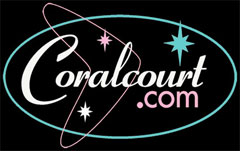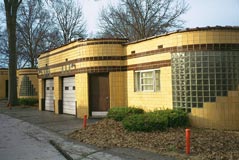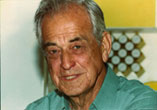







 The
glazed brick motor court, formerly at 7755 Watson Road, was located just
one mile west of the St. Louis city limits. Designed in the 1940’s
Streamline Moderne style, the Coral Court was described by author Michael
Wallis as “the proverbial ‘no-tell motel’ with a definite
touch of class.” The motel was the premier surviving example of a
motor court, an early phase of the motel. It was also highly regarded
as one of the finest examples ever built in this late Art Deco style.
Coral Court first became famous because of its prime location on Route
66, just outside of St. Louis. Heading west on the mother road, it was
a natural stop after a day’s drive from Chicago.
The
glazed brick motor court, formerly at 7755 Watson Road, was located just
one mile west of the St. Louis city limits. Designed in the 1940’s
Streamline Moderne style, the Coral Court was described by author Michael
Wallis as “the proverbial ‘no-tell motel’ with a definite
touch of class.” The motel was the premier surviving example of a
motor court, an early phase of the motel. It was also highly regarded
as one of the finest examples ever built in this late Art Deco style.
Coral Court first became famous because of its prime location on Route
66, just outside of St. Louis. Heading west on the mother road, it was
a natural stop after a day’s drive from Chicago.
 On
June 11, 1941, the St. Louis Daily Record reported that owner John H.
Carr planned to build 10 two-room cabins and a central building at a cost
of seven thousand dollars. St. Louis architect,
Adolph L. Struebig, was hired
to build John Carr’s vision of the best motel in St. Louis. Struebig
was quoted in an interview with E.F. Porter of the St. Louis Post-Dispatch,
“There were a lot of mom-and-pop motels in those days, little buildings
of eight to twelve units. Johnnie didn’t want anything like that,
he wanted something outstanding.” See John Carr with his grandson John Dover.
On
June 11, 1941, the St. Louis Daily Record reported that owner John H.
Carr planned to build 10 two-room cabins and a central building at a cost
of seven thousand dollars. St. Louis architect,
Adolph L. Struebig, was hired
to build John Carr’s vision of the best motel in St. Louis. Struebig
was quoted in an interview with E.F. Porter of the St. Louis Post-Dispatch,
“There were a lot of mom-and-pop motels in those days, little buildings
of eight to twelve units. Johnnie didn’t want anything like that,
he wanted something outstanding.” See John Carr with his grandson John Dover.
Struebig designed and built the original 10 bungalows in grand style. The honey-colored glazed ceramic bricks and large glass block windows gleamed in the sunlight, or reflected the headlights of your 1950 Buick Roadmaster at night.
There were two different architects who designed and built Coral Court, although credit has usually been given to one. During the course of the research for my book I found there was a second architect, Harold Tyrer, who was responsible for more than half of the Coral Court complex. Tyrer designed and built the exceptional 1946 cottages, which feature two rounded bays and pyramid-shaped glass block windows.
 1941 floorplan |
 1946 floorplan |
After World War II, from 1946-48, twenty-three new buildings (or 46 rooms) were completed. Motel enthusiasts refer to this bungalow style as the “Mae West” unit because of the curvy, rounded bays. After the 2-story units were built near the back of the complex, the final tally reached 77 rooms. Yet the highest room number was only #65. This was because of the odd numbering system of the 2-story rooms: #51, 51a, 52, 52a. “A” indicated upstairs rooms.
To roadside fans, Coral Court was a shrine. To many St. Louisans, the motel was a rite of passage. Attending a late night prom party and escaping with a Court towel or matchbook was a must for any local teenager. For many who prefer to remain anonymous, the motel was the place “to get that groove on;” and of course there were always the chaste few who considered it “a monument to adultery”. How did Coral Court get its reputation? Three reasons: (1) The rooms could be rented for a rest period of 4 or 8 hours (initially created as a courtesy to truck drivers), but not actually hourly rates as is often said. (2) Every room had its own garage, so cars were hidden from passersby. The clean and cozy bungalows, with attached private garages, provided whispered asides and off-colored jokes for decades. (3) The management at Coral Court was very discreet. The legend of the motel spread across the United States and beyond.